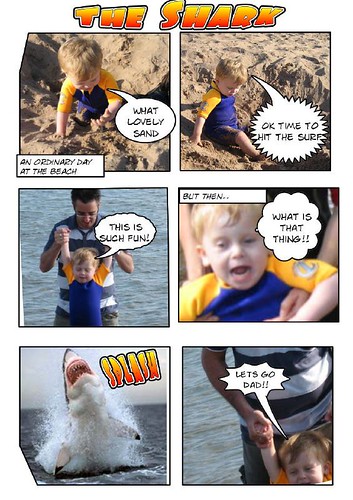Comic Life

Just like children I think that adults go through stages when learning to use new applications. These stages are often a part of my training and are described below:
- Stimulated by or Initial interest- we may be stimulated by an application, perhaps we've seen others use it and we'd like to have a go, or maybe we just sit back and watch others use it. For a while I have watched and read Simon's use of Comic Life on his blog.
- Explore- the playing stage, when we move our eyes along the tool bar and test out the functions. We will create a number of documents, programs, images or programs (depending on the application)
- Practise Rehearse- This is probably the stage I got to yesterday with Comic Life. I had played around with the software and worked at it in order to create something of value.
- Use for intended audience- and by this point you know the application well enough to use it for an audience or a purpose. Hence the comic below was built after a short time of practise and rehearsing until I had gained familiarity with the software and I was happy enough to show you the outcome of my work above.
Comic Life in the National Curriculum
ICT @ KS2
Developing ideas and making things happen
2) Pupils should be taught:
a) how to develop and refine ideas by bringing together, organising and reorganising text, tables, images and sound as appropriate [for example, desktop publishing, multimedia presentations
]
Exchanging and sharing information
3) Pupils should be taught:
a) how to share and exchange information in a variety of forms, including email [Renewed Literacy Frameworkfor example, displays, posters, animations, musical compositions
]
b) to be sensitive to the needs of the audience and think carefully about the content and quality when communicating information [for example, work for presentation to other pupils, writing for parents, publishing on the Internet
] .
The framework mentions the use of comic strips within the ICT applications document. While the extract below also mentions comics as texts for children to engage with while looking at narrative.
Year 3 Narrative - Unit 1
Stories with familiar settings
(3 weeks)
This is the first of four narrative units in Year 3. Prior to teaching the unit, whole-class collections of stories with familiar settings could be established to support independent reading for pleasure. Texts could include films, comics, picture books and written texts. One particular text could be chosen as a class novel, so children experience how a narrative builds up over a period of time. This unit can be linked to other curriculum subjects or themes.
Granted this is reading the comic and not necessarily creating a comic, but pupils could support their literacy work by creating a comic in ICT. This would be a good interpretation of the QCA unit of combining text and images:Unit 3A: Combining text and graphics
In this unit children learn how to communicate messages by using a combination of graphics and text. They also learn the importance of saving their work.








No comments:
Post a Comment